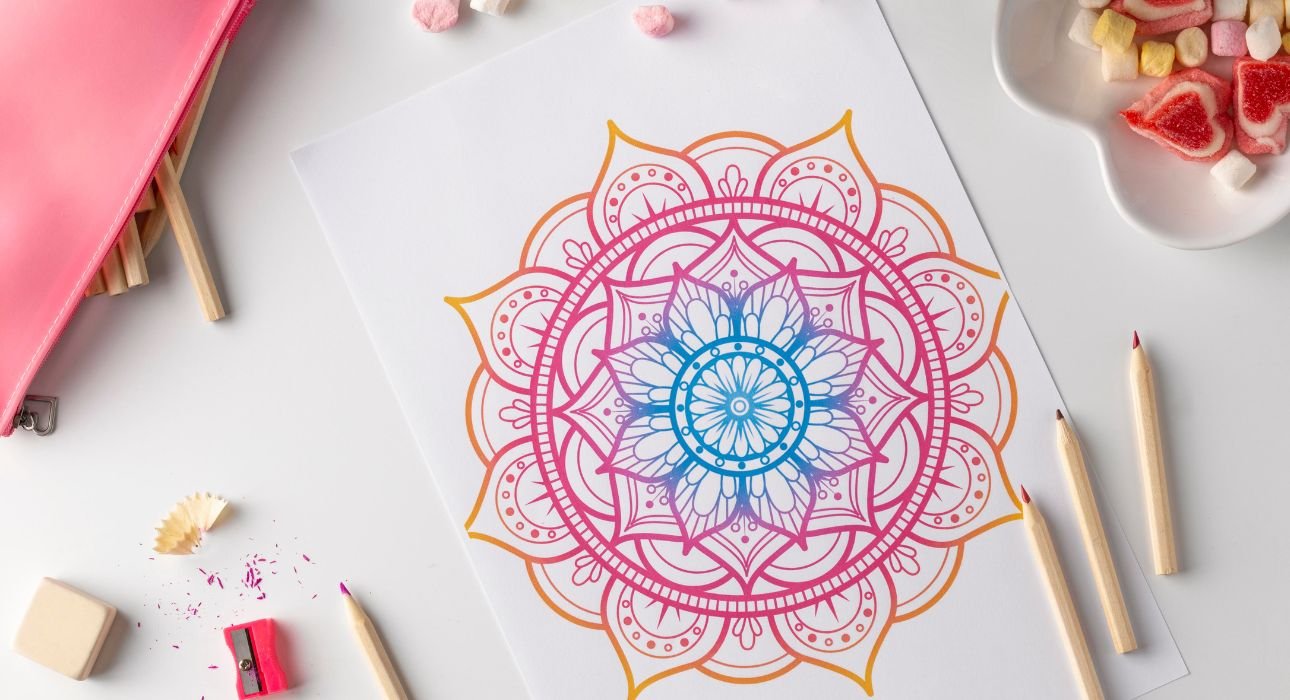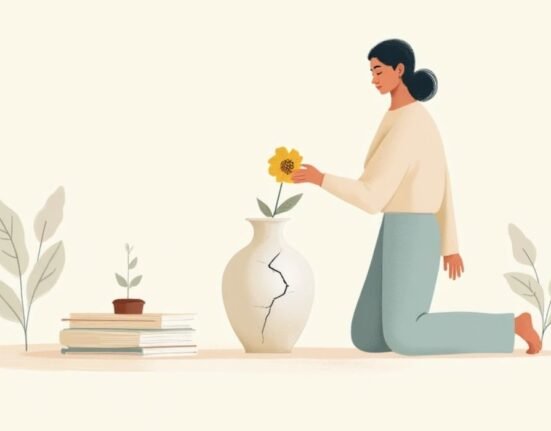Most of our days, we might end up feeling overwhelmed still and inner clarity can be hard to find. Art therapy, particularly the making and meditation on mandalas, has become a soothing yet potent means of healing the mind, body, and spirit. Mandalas, round, usually symmetrical patterns, have their origins in spiritual and cultural practices all over the globe, from Tibetan Buddhism to Native American sand paintings. Now, they are taking their place in contemporary psychological practice, not only as a form of artwork but as tools of transformation and healing therapy.
Read More: The Profound Context of Buddhism and Psychology
The Importance of Arts-Based Therapies
Arts therapies—visual arts, music, dance, and drama—enable participants to convey difficult-to-put-into-words thoughts and feelings. They are especially effective for traumatised, anxious, depressed, or repressed individuals. Creativity and artistic expression enable patients to reach unconscious material, work through emotions in a safe manner, and even control physiological responses. Studies indicate that art therapy is linked with lowered levels of cortisol (the stress hormone), enhanced neuroplasticity, and emotional resilience.
Mandalas in Arts-Based Therapies
Of all the expressive therapy tools, mandalas occupy a unique position. “Mandala” is a Sanskrit word that translates to “circle,” and because it is circular in shape, it represents wholeness, completeness, and the cycle of life. Carl Jung, the founder of analytical psychology, incorporated mandala drawing as a tool for exploring the unconscious and fostering balance in the psyche. According to Jung, mandalas are symbolic of the “Self”, the heart of the psyche.
In therapy, clients can be encouraged to draw mandalas with colours, shapes, and symbols that indicate present emotional states. Unlike other types of art that can intimidate because of perceived “skill levels,” mandalas are welcoming. The symmetry and structure provide a sense of security in their expression, making people feel anchored.
What Disorders Can Mandala Art be helpful in?
Mandala art therapy is most beneficial for:
- Anxiety and Panic Disorders: The repeated, rhythmic action of making mandalas serves as a meditative concentration that quietens the mind.
- Depression: The act of colouring and drawing mandalas can stimulate the reward system in the brain, creating brief experiences of happiness and achievement.
- PTSD and Trauma: Mandalas provide a systematic means to navigate randomness and recreate a sense of structure and safety.
- Obsessive-Compulsive Disorder (OCD): The regulation and precision required can serve as a temporary release while creating flexibility.
- ADHD and Attention Struggles: Mandalas enhance sustained attention and mindfulness, facilitating the building of concentration skills.
Mandalas and Cognitive Concentration
Making or colouring mandalas increases cognitive concentration by engaging both hemispheres of the brain. The repetitive designs call for sustained attention, fine motor, and decision-making (e.g., colour selection or design completion). In several ways, the exercise is much like mindfulness meditation. It draws the mind from wandering thoughts and into the “now.” Research indicates that even short periods of colouring mandalas can enhance focus, decrease test anxiety, and aid in emotional regulation in children as well as adults. The systematic pattern gets the brain into a flow state, a highly absorbed mental state in which time appears to stand still and concentration becomes automatic.
Read More: How to Train Your Creativity (Even If You Think You’re Not Creative)
How Mandalas Inculcate Creativity
While mandalas tend to be symmetrical, they are by no means rigid. Inside the circle, there is freedom, freedom to select colour, assign meaning, and create novel symbols. This mesh of structure and creativity provides the person with the ability to probe the subject of identity, wants, and fears in a non-intimidating manner. For the creatively frustrated, mandala work can “unjam” creative energy. The mere act of creating within a circular boundary gives parameters that paradoxically entice investigation. There is no “wrong” way to do a mandala—only a process of inner discovery.
Read More: Psychology of Spiritual Awakening: Transforming Self and Society
Mandalas for Emotional Balance and Spiritual Growth
Aside from their psychological value, mandalas tend to be spiritually charged. Mandalas are employed in meditation and ritual as a vehicle to enlightenment in Eastern cultures. Even where they are secular, however, people find that they feel a spiritual connection while drawing mandalas, focusing on something beyond themselves. The repetitive geometry in itself is calming to the nervous system, and the unique circular structure echoes nature’s patterns, flowers, galaxies, ripples on water, reminding us of our interdependence.
Mandala art becomes not only a therapy, but a healing ritual and renewal. In a world where mental health issues are on the increase, mandalas provide a subtle yet powerful intervention. They don’t require artistic ability, just openness. Used either as a healing tool for recovery from trauma, emotional regulation, spiritual inquiry, or concentration, mandalas encourage us back to self, one shape, one colour, one breath at a time.
Mandalas in Group Therapy and Community Settings
Mandalas in group therapy are a common activity that promotes bonding within mutual respect of individual space. Some examples include:
- Collaborative mandalas: Each individual adorns a portion of a large circle, representing community and interdependence.
- Themed mandalas: Groups work on emotions such as anger, loss, or hope through symbolic expression.
- Reflective sharing: Individuals interpret their mandalas collectively, increasing insight and understanding.
In community mental health settings, mandala workshops can foster resilience, cross-cultural understanding, and collective healing, especially after collective trauma or loss.
Getting Started: Your Own Mandala Journal
You don’t need fancy supplies or training to start benefiting from mandalas. Here’s a quick guide:
- What You’ll Need: Blank journal or sketchbook, Colored pens, pencils, or markers, A round object to trace a circle (or printable mandala templates)
- Simple Mandala Practices:
- Morning Mandala: Begin the day by colouring or sketching shapes and colours within a circle that mirror your current emotional state.
- Emotion Circle: Select an emotion (e.g., sadness, serenity) and colour, shape, and texture it with.
- Intention Mandala: Centre on a word or affirmation and mandala around it (e.g., “healing,” “clarity,” “strength”).
- Tips:
- Don’t strive for “pretty.” Strive for honesty.
- Let colours and patterns lead you intuitively.
- Pause after completing: What is this mandala telling you about how you’re feeling or what you need?
As you keep this journal over time, it becomes a visual diary—a map of your emotional landscape.
Mandalas are not just art. They’re instruments of self-regulation, creativity, and profound healing. In their soothing geometry, we discover room to breathe, look inward, and reconnect with our feelings, our minds, and our sense of self. Whether in clinical treatment or in the stillness of your bedroom, the mere act of colouring or drawing inside a circle can effect profound change. The next time everything seems to be too much, pick up a pencil and draw a circle. Begin at the centre, and observe what unfolds.
References +
Kaimal, G., Ray, K., & Muniz, J. (2016). Reduction of Cortisol Levels and Participants’ Responses Following Art Making. Art Therapy, 33(2), 74–80. https://doi.org/10.1080/07421656.2016.1166832
Jung, C. G. (1965). Memories, Dreams, Reflections. New York: Vintage Books. Curry, N. A., & Kasser, T. (2005). Can coloring mandalas reduce anxiety? Art Therapy, 22(2), 81–85. https://doi.org/10.1080/07421656.2005.10129441
Malchiodi, C. A. (2012). Handbook of Art Therapy. Guilford Press. Schrade, C., Tronsky, L. N., & Kaiser, D. (2011). Physiological Effects of Art Making and Mandala Drawing: A Pilot Study. Art Therapy, 28(2), 64–69. https://doi.org/10.1080/07421656.2011.578058













Leave feedback about this